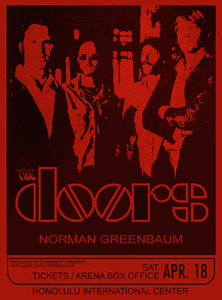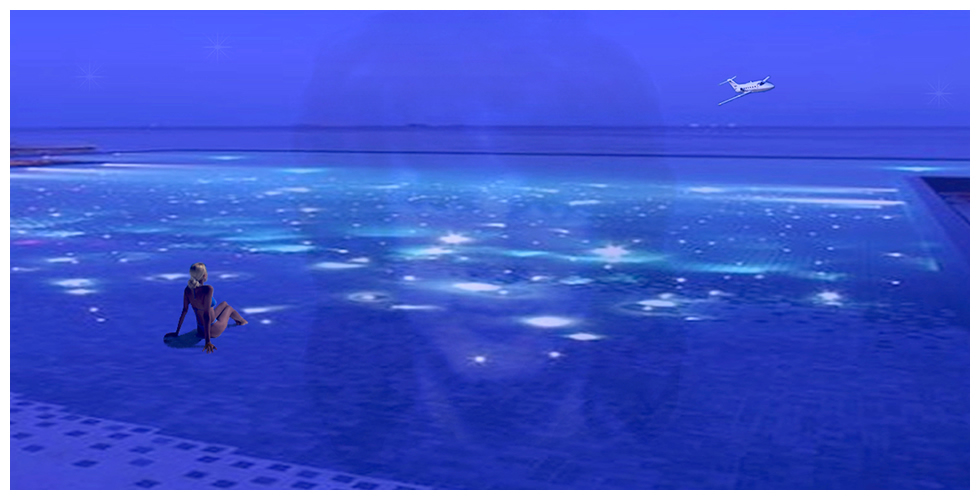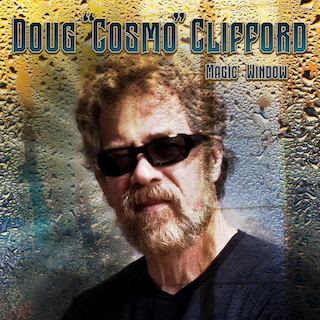
Hawaii : The Early Years
Russell grew up in Kailua, Hawaii, on the island of Oahu. His father Dan worked as a radio electronics engineer for the Navy at Pearl Harbor. His mother Fran was a stay at home housewife. It was the early 1960s and most days after school Russell would ride his bike to Kailua Beach, with his homemade surfboard towed behind, where he and his friends would paddle out to Flat Island or surf the Kailua shore break until sunset.

At the age of 14 Russell met a new kid on the block who played a Martin D28 acoustic. When Russell heard him play it for the first time he was spellbound by the sound. He talked the new kid into teaching him 3 chords, but he picked it up so quickly that the kid refused to teach him any more. This was the beginning of Russell’s lifelong fascination with the guitar.
His parents bought him his first acoustic for Christmas that year, followed by his first electric, a Sears Silvertone with an amp built into its case. He developed his playing by figuring out the chords to songs he heard on the radio. For his 15th birthday his parents drove him to Honolulu and bought him a cherry red Les Paul Junior, his dream guitar.

Dan DaShiell held several patents in early tape recording technology, and he taught Russell how to record sound on sound on a 1/4 inch two track. On days when the surf wasn’t any good, he’d spend hours practicing and overdubbing guitar. In addition to his sound on sound experiments, on weekends he’d sit in with a few other rock ‘n’ rollers in the neighborhood who would set up their amps and jam.
Florida : The Sugar Shack Days
Dan and Fran DaShiell moved the family to Florida in 1963, a big disappointment for Russell. The Atlantic ocean surf couldn’t compare to Hawaii, so he gave up surfing. But things worked out well for his music – he joined his first rock band that year.
On weekends his band gigged at a local night club called the Melbourne Beach Casino. He was under age but nobody ever checked his ID. The band lineup was 2 guitars, drums and a lead singer. The 2nd guitarist tried to convince Russell to play bass, but he didn’t want to give up the guitar. So they continued on without a bass player.

Around that time the Beatles were topping the charts, and Russell took over lead vocal duties for the band. Now a trio with 2 guitars and drums, they added a few Beatles songs to their repertoire and focused on more teen oriented gigs.
A new club called the Sugar Shack had opened up, featuring 3 stages. lt was immediately the most popular gig in town. Russell’s band played there one night on one of the smaller stages. After ending their set with the Beatles’ All My Lovin’, a bass player named Doug Killmer introduced himself and asked Russell if he’d be interested in joining his band, the Sonics. Russell was ready for a change, so that week he sat in with the Sonics and decided to take the gig.
Doug and Russell complemented each other well, but over the next few months they began to feel the Sonics were holding them back. A personnel change was imminent, and a hotshot local drummer named Rick Jaeger was just what the doctor ordered. A half dozen phone calls later they persuaded Rick to join them and form a new band. Rick suggested they call themselves the Beau Gentry. They were 17 years old.
The Midwest : Band On The Road
After a year of playing beach clubs and fraternity parties in Florida, the Beau Gentry were ready to move forward with their career. They asked their good friend Sam McCue of the Legends for help. Sam called his agent in Wisconsin, Ken Adamany, who agreed to book the band for a summer of gigs up north. The ‘Invasion From The South’ tour went so well that the Beau Gentry ended up gigging in the area for over 2 years.

By that time Jimi Hendrix and the Cream were dominating the music scene, and the Beatles’ Sgt. Pepper’s Lonely Hearts Club Band album was released. The Beau Gentry were now writing their own songs, and they grew weary of playing covers, feeling like a human juke box. So a year after the infamous Summer Of Love, in 1968 they decided to move to San Francisco, play all original music and try to secure a record deal.
San Francisco : Spirit In The Sky
Doug relocated to Marin County a few months early. Then Rick and Russell drove out in a Z28, towing a U-haul trailer packed with a Marshall stack and a set of Rogers drums. They began rehearsing as a trio in the basement of a house in San Anselmo that they shared with the A B Skhy band. Doug suggested calling their new band Crowfoot.
Doug mentioned he had a recording gig with Lovin’ Spoonful producer Erik Jacobsen. Erik was looking for a lead guitar player for the sessions, so at Doug’s suggestion he invited Russell to audition at the Sausalito Heliport. Russell got the gig. The artist was Norman Greenbaum, and after several rehearsals they cut a batch of songs at Coast Recorders in San Francisco. Doug and Russell were initially paid $50 a song.

Over the next several months Crowfoot played various gigs in the Bay area, including the Matrix and one night at the Fillmore West, but a record deal proved to be elusive.
In June of 1969, Harvey Mandel invited Rick and Russell to join his band for a summer tour. With Crowfoot making no progress, they decided to dissolve the trio and take the gig with Harvey. Doug returned to the midwest to work with a blues band.
After the tour, Russell stayed on with Harvey to record his Games Guitars Play album at Wally Heider’s in San Francisco. Rick joined the A B Skhy band. Russell then got an offer from Creedence engineer Russ Gary, who engineered Harvey’s album, to record a solo album at Wally Heider’s, using the band name Crowfoot. With Rick on drums, they recorded the album on spec, mostly late at night.
In early 1970 Russell got a call from Erik Jacobsen. One of the songs he and Doug recorded with Greenbaum months earlier, “Spirit In The Sky”, was getting major airplay and selling 25,000 units a day. Russell called Doug, who was back in Marin County, and they quickly put a band together with Norman to do a national tour, booked by agent Dan Weiner. Spirit ended up hitting #1 on most charts and sold over 2 million units.

The Spirit In The Sky tour included arena gigs with Chicago, Grand Funk Railroad, The Moody Blues, Spirit, John Mayall, Iron Butterfly and many others. The band also appeared on Dick Clark’s American Bandstand. The highlight of the tour for Russell was appearing with The Doors at the Honolulu International Center. It was a great way to return to Hawaii where he grew up.

After the Greenbaum tour Russell signed a deal with Paramount Records for the Crowfoot album he recorded with Russ Gary. Paramount wanted him to support it with a tour so he put a band together with Rick Jaeger, their old friend Sam McCue, and Bill Sutton on bass. Ken Adamany, who would later manage Cheap Trick, booked a series of shows in Wisconsin, followed by a showcase at the Bitter End in New York.
Hollywood Hills : More Recording & Touring
In 1971, after recording a 2nd Crowfoot album with Sam and drummer Don Francisco, Russell moved to the Hollywood Hills and built an 8 track studio in his house, signing a record deal with ABC Dunhill. Jaeger eventually joined the Dave Mason Band.
Over the next several years Russell focused on writing, recording and doing session work in Hollywood. Projects included a John Sebastian album, two Greenbaum albums, a tour with Danny O’Keefe, a TV series with Phil Everly, and a Long Beach Arena gig playing bass for Bo Diddley, one of the first rock artists he saw as a kid in Hawaii.

In the late 70s Russell teamed up with Creedence members Doug Clifford and Stu Cook for several albums, including Tom Fogerty’s Myopia. They also did a concert tour of the USA and Europe highlighted by a Knebworth, England gig with Lynyrd Skynyrd, 10CC and the Rolling Stones, playing for an audience of over 100,000.

In 1978 Russell recorded a solo album backed by Doug and Stu called Elevator, signing a deal with CBS Records. He then moved to Las Flores Canyon in Malibu and set up a 24 track studio in his house. He wrote and recorded over 50 songs that year, enjoying the creative freedom of unlimited studio time.

Island Life & Foreverland
From 1980 to 2000 Russell continued writing and recording, signing a singles deal with Sonet Records of Sweden in the mid 1980s. He also traveled to Norway, Finland, Denmark, Germany, France, Italy, Spain, Greece, Hong Kong and Australia, either working on music projects or just experiencing life in interesting places.
By the year 2000 Dan and Fran DaShiell had passed away, and Russell decided to move back to Hawaii. After a few years of artistic hiatus on Maui he returned to L.A. with an instrumental album called Island Life, which he’s currently remixing for a 2023 release. He’s also finishing up Foreverland, a 10 song album from his Foreverland Forest project.

Studio Update: Russell’s single IT’S A LONELY LIFE will be released in 2023.

✺
From Cosmo’s Vault: MAGIC WINDOW by CCR drummer Doug “Cosmo” Clifford.

Another Cosmo’s Vault LP: FOR ALL THE MONEY IN THE WORLD by Clifford / Wright.

New for 2023: Doug “Cosmo” Clifford CALIFORNIA GOLD featuring Bobby Whitlock.

✺

